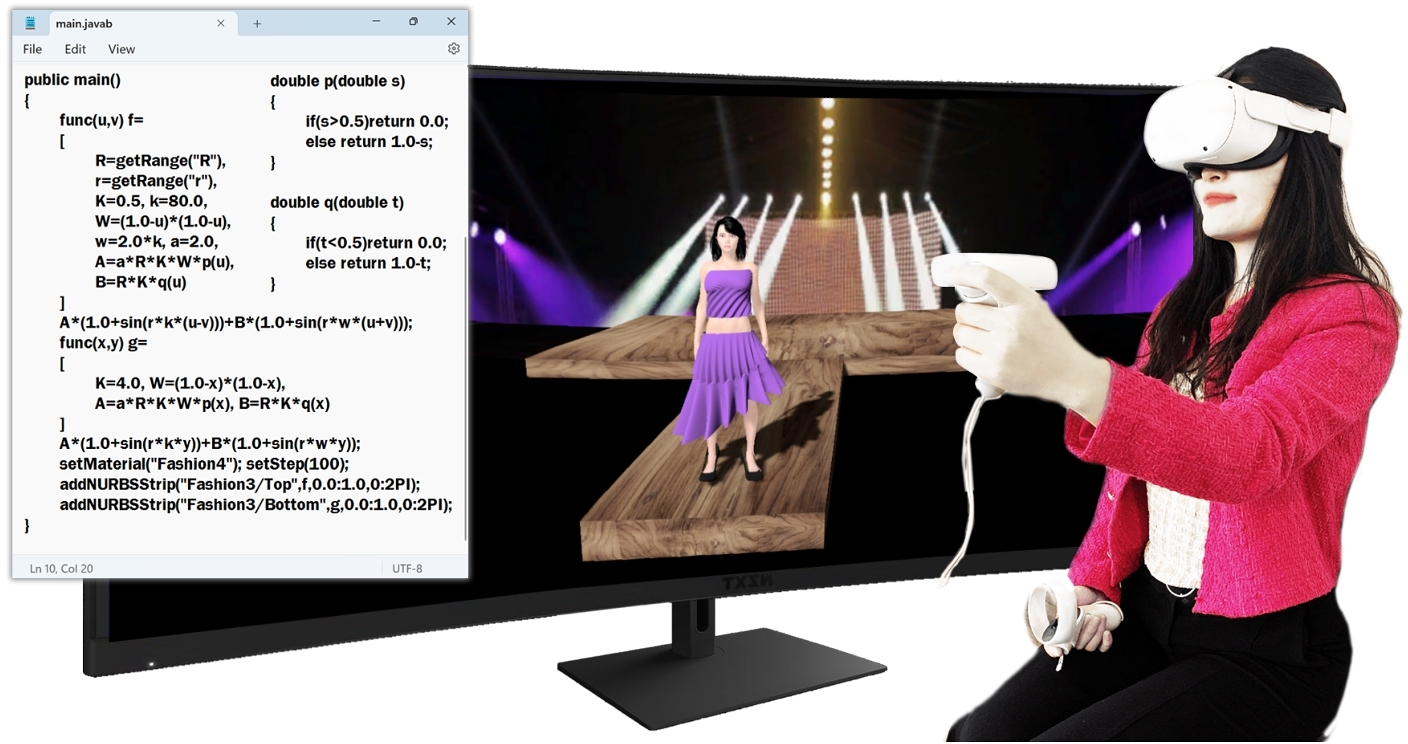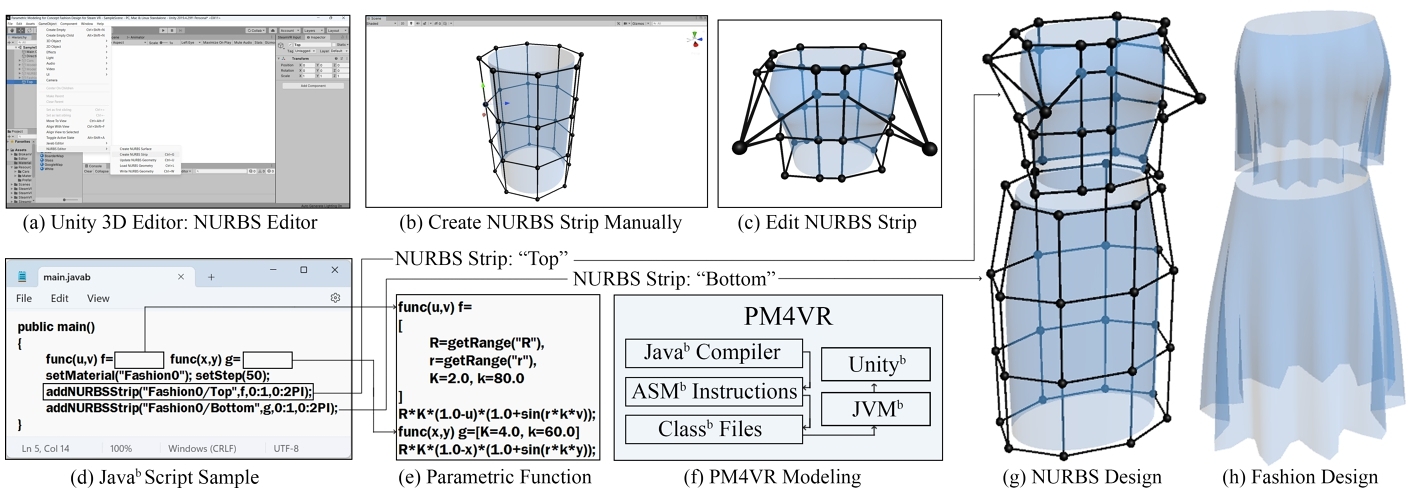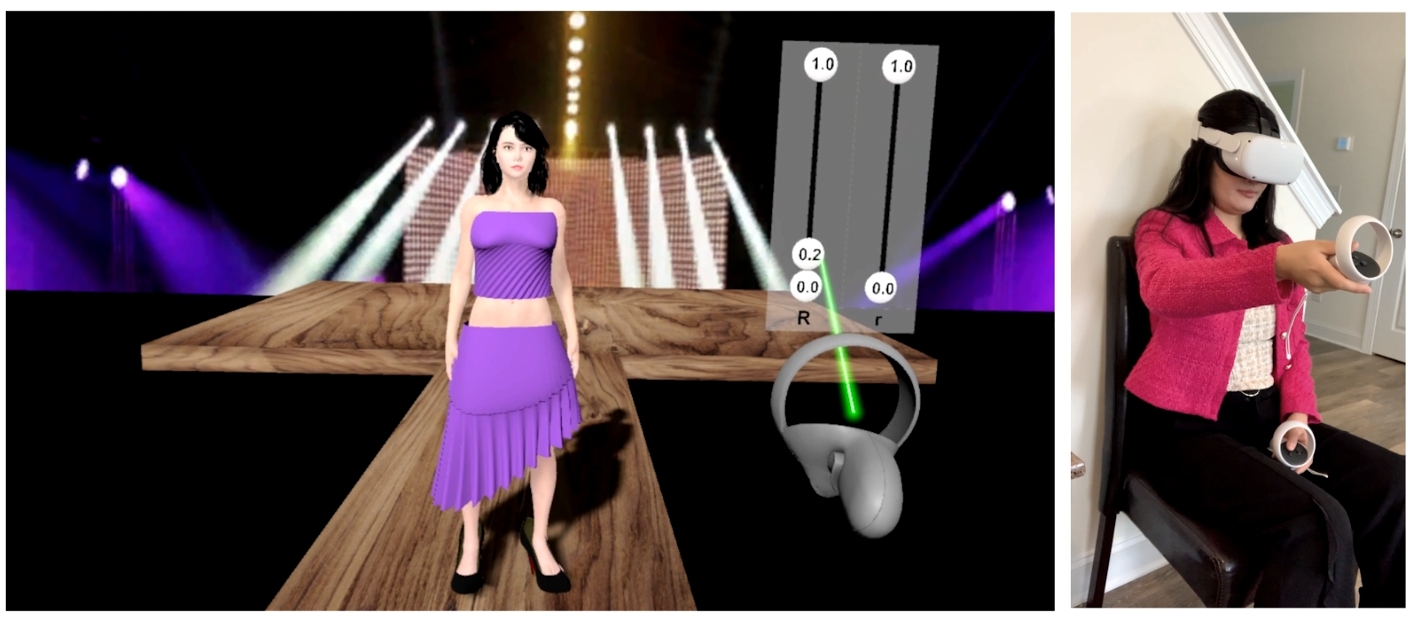PM4Fashion: A Scriptable Parametric Modeling Interface for Conceptual Fashion Design Using PM4VR
DOI: https://doi.org/10.1145/3670105.3670159
CNIOT 2024: 2024 5th International Conference on Computing, Networks and Internet of Things, Tokyo, Japan, May 2024
In the dynamic realm of fashion design, integrating emerging technologies of computational intelligence is essential to enhance creative activities and bring forth novel design concepts. This paper introduces PM4Fashion, a cutting-edge scriptable parametric modeling interface for conceptual fashion design. Leveraging the capabilities of PM4VR (Parametric Modeling for Virtual Reality), PM4Fashion provides designers with a novel interactive toolset to ideate and iterate conceptual fashion design in a virtual environment through diverse design possibilities of advanced parametric modeling technology via virtual reality-enabled platforms.
ACM Reference Format:
Wanwan Li. 2024. PM4Fashion: A Scriptable Parametric Modeling Interface for Conceptual Fashion Design Using PM4VR. In 2024 5th International Conference on Computing, Networks and Internet of Things (CNIOT 2024), May 24--26, 2024, Tokyo, Japan. ACM, New York, NY, USA 5 Pages. https://doi.org/10.1145/3670105.3670159


1 INTRODUCTION
In the ever-evolving landscape of fashion design [5, 20], the integration of advanced technology of Computer-Aided Design (CAD) [3, 17, 19] and computational intelligence [16, 25] has become pivotal for staying at the forefront of innovation. Responding to the trend [1] that the fashion industry embraces technological advancements [21], the integration of parametric modeling and virtual reality (PM4VR) [9, 12, 13, 14, 15] has the potential to be a powerful tool for conceptual fashion design [8, 18, 22]. By combining the flexibility of parametric modeling [4, 6, 10, 11, 23, 24] with the immersive nature of virtual reality [2, 7], this paper introduces PM4Fashion, a novel scriptable parametric modeling interface for conceptual fashion design in conjunction with the extended interface of PM4VR, and explores its integration with PM4VR to provide with a cutting-edge solution for conceptual fashion design.
Fig. 1 provides a glimpse into the capabilities of PM4Fashion. In this example, a conceptual fashion designer crafts a Java♭ script (depicted in the left figure), which serves as the blueprint for the envisioned garment. The real-time execution of the Java♭ script on PM4Fashion results in the instantaneous generation of a realistic 3D conceptual fashion model (shown in the middle figure). The immersive experience takes a remarkable leap forward as PM4Fashion connects with the Oculus Quest 2 VR headset via the SteamVR plugin. Now equipped with VR controllers, the designer steps into a virtual environment (as depicted in the right figure), allowing them to fine-tune parameters on a fashion show stage, transforming the conceptual design into a vivid showcase. This teaser encapsulates the integration of scriptable parametric modeling and virtual reality, showcasing the transformative potential of PM4Fashion in revolutionizing the conceptual fashion design process. PM4Fashion aims to revolutionize the way designers conceptualize and realize their ideas and empowers designers with a versatile platform that combines parametric modeling with immersive experience in VR, fostering creativity and efficiency during the design process.
2 OVERVIEW
Fig. 2 presents an overview of our proposed PM4Fashion-based solution for parametric fashion design. As shown in Fig. 2 (a), NURBS Editor, which is a Unity 3D plugin developed by us using the C# script, is serving as an interactive toolkit tailored for NURBS strip modeling. NURBS strip modeling is a pivotal feature integrated into our proposed NURBS Editor for parametric fashion design purposes. As shown in Fig. 2(b), by pressing the hotkeys of "Ctrl+G", the NURBS Editor automatically generate a NURBS strip initially set as a default shape that looks like "column roll". Subsequently, as shown in Fig. 2 (c), designers can update NURBS strips by dragging their control points through mouse interactions and pressing the hotkeys of "Ctrl+U". As shown in Fig. 2 (d), a Java♭ script sample is crafted by the designer, where the blanks represent the missing coding blocks of parametric functions for the fashion design as shown in Fig. 2 (e). By executing this Java♭ script on PM4VR modeling interface as shown in Fig. 2 (f) along with the NURBS strip designs which were saved on file by pressing the hotkeys of "Ctrl+W" as shown in Fig. 2 (g), designers can view PM4Fashion's output in real-time as the parametric fashion designs shown in Fig. 2 (h).
3 TECHNICAL APPROACH
To enable NURBS geometry operations within Unity3D Editor, we have created a plugin consisting of two C# scripts: "NURBSGeometry.cs" and "NURBSEditor.cs." The "NURBSEditor.cs" script is placed in the "Assets/Editor" directory, ensuring its integration into the Unity3D Editor's dropdown menu. The "NURBSGeometry.cs" script is designed to be attached to a GameObject within the scene, serving as a MonoBehaviour component. Key combination "Ctrl+G" serves as a trigger for generating a default NURBS strip in Unity3D Editor, initially configured as a column roll with a 4x8 grid of control points. This provides users with a quick starting point for NURBS strip geometry. Subsequent dynamic refinement is made possible through user manipulation of control point positions or adjustments to the radius, allowing for modification of weights. The application of these changes is executed with "Ctrl+U" command, ensuring real-time updates. To save and store the designed NURBS strips at any time, users can export the control points’ positions and weights into a file using "Ctrl+W" command for data preservation. Additionally, the plugin offers flexibility to load pre-existing NURBS strip files into the scene with "Ctrl+L" command, enabling efficient backup for resuming any paused design process. These operations establish an interactive environment within Unity3D Editor, empowering users to create and manage NURBS strips.

(1)
Parametric Function. In PM4Fashion, we propose a Java♭ function of addNURBSStrip("NURBS name", f(u, v), u0 : u1, v0 : v1). The mathematical processing involves constructing the surface by initially loading the NURBS strip geometry from the "⟨ NURBS name⟩.NURBS" file denoted as parametric function s(u, v). Subsequently, the NURBS strip is deformed along the normal direction at each point (u, v), with a displacement defined by the parametric function f(u, v). This deformation results in a new parametric surface g(u, v) calculated with the following equation:
(2)

4 EXPERIMENT RESULTS
To evaluate the efficacy of our proposed technical methodology, a comprehensive set of numerical experiments was conducted on conceptual fashion designs utilizing the scriptable parametric modeling interface of PM4Fashion. The implementation of our proposed approach was carried out within Unity 3D of 2019 version. The numerical experiments generated results on a system equipped with an Intel Core i5 CPU, 32GB DDR4 RAM, and an NVIDIA GeForce GTX 1650 4GB GDDR6 Graphics Card. The use of Unity 3D provided a reliable platform for validating the capabilities and practicality of our proposed technical approach in the context of fashion design.

In Fig. 5, a visual representation is provided of parametric conceptual fashion designs that maintain consistent parameter values of R = 0.5 and r = 0.5. This figure encompasses three rows, each featuring a different NURBS strip design detailed in Fig. 4. Additionally, the figure illustrates six distinct columns, each associated with a unique design parametric function detailed in Fig. 3. The combination of the three NURBS strip designs and the six design parametric functions results in a matrix of diverse fashion design outputs. This presentation allows for a comprehensive examination of the impact of both NURBS strip designs and parametric functions on the final conceptual fashion outcomes, providing valuable insights into the versatility and adaptability of the proposed modeling approach.
Fig. 6 captures a user engaging in the fine-tuning a fashion design's parameter values using PM4Fashion interface in a virtual environment of fashion stage. The immersive nature of VR allows user to interact with the design elements in 3D space, providing a dynamic and intuitive platform for adjustments. The user, equipped with VR devices, is able to manipulate the fashion design's parameters in real-time, fostering an immersive experience. This approach not only enhances the user's control over the design process but also highlights the interactive capabilities of PM4Fashion in VR, facilitating a intuitive and efficient workflow for fashion design. For more details, please watch the experiment result video available at the following link: https://youtu.be/VcqyLADLs7A

5 CONCLUSION
This paper introduces PM4Fashion, a novel scriptable parametric modeling interface tailored for conceptual fashion design, seamlessly integrated with PM4VR. PM4Fashion represents a paradigm shift in conceptual fashion design by combining the power of scriptable parametric modeling with the immersive experience of virtual reality. This integrated platform empowers designers with flexibility, efficiency, and creativity, ushering in a new era of innovation in the fashion industry. As technology continues to evolve, PM4Fashion stands at the forefront, bridging the gap between imagination and realization in the dynamic world of fashion design.
REFERENCES
- S Burke and R Sinclair. 2015. Computer-aided design (CAD) and computer-aided manufacturing (CAM) of apparel and other textile products. In Textiles and Fashion. Elsevier, 671–703.
- Lorenzo Donatiello, Elena Morotti, Gustavo Marfia, and Sonia Di Vaio. 2018. Exploiting immersive virtual reality for fashion gamification. In 2018 IEEE 29th Annual International Symposium on Personal, Indoor and Mobile Radio Communications (PIMRC). IEEE, 17–21.
- Shereen Saied Mohamed Hasan. 2019. A comparative study on the role of fashion drawings for the design of women's clothing using CAD technology. International Design Journal 9, 4 (2019), 375–390.
- Kateryna I Kyivska, Svitlana V Tsiutsiura, Mikola I Tsiutsiura, Olena V Kryvoruchko, Andrii V Yerukaiev, and Vladyslav V Hots. 2019. A study of the concept of parametric modeling of construction objects. Tsiutsiura, Svitlana and I. Tsiutsiura, Mikola and V. Kryvoruchko, Olena and Yerukaiev, Andrii V. and V. Hots, Vladyslav, A Study of the Concept of Parametric Modeling of Construction Objects (2019), 636–646.
- Sue Jenkyn Jones. 2011. Fashion design. Laurence King Publishing.
- E Kalkan, FY Okur, and AC Altunışık. 2018. Applications and usability of parametric modeling. Journal of Construction Engineering, Management & Innovation 1, 3 (2018), 139–146.
- FAİK Kartelli, Markus Berger, SELDA Kozbekçi Ayranpınar, and NESRİN Önlü. 2018. The future of textile and fashion design in virtual reality. (2018).
- Jee Hyun Lee, Eunkyoung Yang, and Zhong Yuan Sun. 2021. Using an immersive virtual reality design tool to support cognitive action and creativity: Educational insights from fashion designers. The Design Journal 24, 4 (2021), 503–524.
- Wanwan Li. 2022. PM4VR: A Scriptable Parametric Modeling Interface for Conceptual Architecture Design in VR. In Proceedings of the 18th ACM SIGGRAPH International Conference on Virtual-Reality Continuum and its Applications in Industry. 1–8.
- Wanwan Li. 2023. Animating Parametric Kinetic Spinner in Virtual Reality. In 2023 7th International Conference on Advances in Image Processing (ICAIP 2023). 1–5.
- Wanwan Li. 2023. SurfChessVR: Deploying Chess Game on Parametric Surface in Virtual Reality. In 2023 9th International Conference on Virtual Reality (ICVR). IEEE, 171–178.
- Wanwan Li. 2024. PM4Car: A Scriptable Parametric Modeling Interface for Concept Car Design Using PM4VR.. In 2024 International Conference on Computer Graphics and Image Processing (CGIP). 1–6.
- Wanwan Li. 2024. PM4Music: A Scriptable Parametric Modeling Interface for Music Visualizer Design Using PM4VR. In 2024 International Conference on Digital Signal Processing (ICDSP). 1–5.
- Wanwan Li. 2024. PM4Pottery: A Scriptable Parametric Modeling Interface for Conceptual Pottery Design Using PM4VR. In 2024 International Conference on Automation, Robotics, and Applications (ICARA). 1–5.
- Wanwan Li. 2024. PM4WireArt: A Scriptable Parametric Modeling Interface for Conceptual Wire Art Design Using PM4VR. In 2024 International Conference on International Conference on Information and Computer Technologies (ICICT). 1–6.
- Linlin Liu, Haijun Zhang, Yuzhu Ji, and QM Jonathan Wu. 2019. Toward AI fashion design: An Attribute-GAN model for clothing match. Neurocomputing 341 (2019), 156–167.
- Yong-Jin Liu, Dong-Liang Zhang, and Matthew Ming-Fai Yuen. 2010. A survey on CAD methods in 3D garment design. Computers in industry 61, 6 (2010), 576–593.
- Minjung Park, Hyunjoo Im, and Do Yuon Kim. 2018. Feasibility and user experience of virtual reality fashion stores. Fashion and Textiles 5, 1 (2018), 1–17.
- Abu Sadat Muhammad Sayem, Richard Kennon, and Nick Clarke. 2010. 3D CAD systems for the clothing industry. International Journal of Fashion Design, Technology and Education 3, 2 (2010), 45–53.
- Richard Sorger and Jenny Udale. 2017. The fundamentals of fashion design. Bloomsbury Publishing.
- Tatjana Spahiu, Ermira Shehi, and Erald Piperi. 2014. Advanced CAD/CAM systems for garment design and simulation. In 6th International conference of textile. 1–6.
- Sandra Starkey, Samirah Alotaibi, Heather Striebel, Jaclyn Tejeda, Katie Francisco, and Nicole Rudolph. 2021. Fashion inspiration and technology: virtual reality in an experimental apparel design classroom. International Journal of Fashion Design, Technology and Education 14, 1 (2021), 12–20.
- Milena Stavric and Ognen Marina. 2011. Parametric modeling for advanced architecture. International journal of applied mathematics and informatics 5, 1 (2011), 9–16.
- Michela Turrin, Peter Von Buelow, and Rudi Stouffs. 2011. Design explorations of performance driven geometry in architectural design using parametric modeling and genetic algorithms. Advanced Engineering Informatics 25, 4 (2011), 656–675.
- Kristen Vaccaro, Tanvi Agarwalla, Sunaya Shivakumar, and Ranjitha Kumar. 2018. Designing the future of personal fashion. In Proceedings of the 2018 CHI Conference on Human Factors in Computing Systems. 1–11.
Permission to make digital or hard copies of all or part of this work for personal or classroom use is granted without fee provided that copies are not made or distributed for profit or commercial advantage and that copies bear this notice and the full citation on the first page. Copyrights for components of this work owned by others than the author(s) must be honored. Abstracting with credit is permitted. To copy otherwise, or republish, to post on servers or to redistribute to lists, requires prior specific permission and/or a fee. Request permissions from permissions@acm.org.
CNIOT 2024, May 24–26, 2024, Tokyo, Japan
© 2024 Copyright held by the owner/author(s). Publication rights licensed to ACM.
ACM ISBN 979-8-4007-1675-1/24/05.
DOI: https://doi.org/10.1145/3670105.3670159